“THE DAY THE MUSIC DIED.”
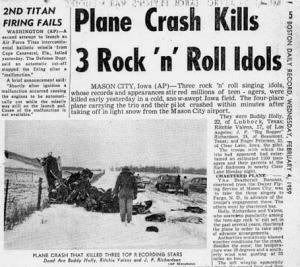
On this day in 1959, rising American rock stars Buddy Holly, Ritchie Valens and J.P. "The Big Bopper" Richardson are killed when their chartered Beechcraft Bonanza plane crashes in Iowa a few minutes after takeoff from Mason City on a flight headed for Moorehead, Minnesota. Investigators blamed the crash on bad weather and pilot error. Holly and his band, the Crickets, had just scored a No. 1 hit with "That'll Be the Day."

'The Big Bopper' - Buddy Holly - Richie Valens
After mechanical difficulties with the tour bus, Holly had chartered a plane for his band to fly between stops on the Winter Dance Party Tour.
Holly, born Charles Holley in Lubbock, Texas, and just 22 when he died, began singing country music with high school friends before switching to rock and roll after opening for various performers, including Elvis Presley. By the mid-1950s, Holly and his band had a regular radio show and toured internationally, playing hits like "Peggy Sue," "Oh, Boy!," "Maybe Baby" and "Early in the Morning." Holly wrote all his own songs, many of which were released after his death and influenced such artists as Bob Dylan and Paul McCartney.
Another crash victim, J.P. "The Big Bopper" Richardson, 28, started out as a disk jockey in Texas and later began writing songs. Richardson's most famous recording was the rockabilly "Chantilly Lace," which made the Top 10. He developed a stage show based on his radio persona, "The Big Bopper."
The third crash victim was Ritchie Valens, born Richard Valenzuela in a suburb of Los Angeles, who was only 17 when the plane went down but had already scored hits with "Come On, Let's Go," "Donna" and "La Bamba," an upbeat number based on a traditional Mexican wedding song (though Valens barely spoke Spanish).
In 1987, Valens' life was portrayed in the movie La Bamba, and the title song, performed by Los Lobos, became a No. 1 hit. Valens was posthumously inducted into the Rock and Roll Hall of Fame in 2001.
Singer Don McLean memorialized Holly, Valens and Richardson in the 1972 No. 1 hit "American Pie," which refers to February 3, 1959 as "the day the music died."
"It was already snowing at Minneapolis, and the general forecast for the area along the intended route indicated deteriorating weather conditions," wrote the Civil Aeronautics Board investigators six months after the crash that killed Buddy Holly, Ritchie Valens and J.P. "the Big Bopper" Richardson on this day in 1959. "The ceiling and visibility were lowering...and winds aloft were so high one could reasonably have expected to encounter adverse weather during the estimated two-hour flight."
All of this information was available to 21-year-old pilot Roger Peterson, if only he had asked for it. Instead, he relied on an incomplete weather report and on the self-confidence of youth in making the decision to take off from Clear Lake, Iowa, shortly after midnight on February 3, 1959. Untrained and uncertified in instrument-only flight, Peterson was flying into conditions that made visual navigation impossible. "Considering all of these facts," the investigating authorities concluded, "the decision to go seems most imprudent."
The young pilot's decision to go may well have been influenced by the eagerness of his almost equally young client, Buddy Holly, to spare himself and his backing band another miserable night in the unheated tour bus that had already sent his drummer to the hospital with symptoms of frostbite.
Eleven days into a scheduled 23-stop tour, Holly was fed up, worn out and looking forward to a good night's rest in a warm bed before the next night's show in Moorhead, Minnesota. In a similar mindset was a tired and ill J.P. Richardson, who played on the sympathies of Holly's guitarist to wangle his seat on the flight with Holly.
That guitarist was future country legend Waylon Jennings.
Meanwhile Tommy Allsup, Holly's guitarist, offered to flip a coin with up-and-coming young star Ritchie Valens for his seat.
And so it was that Peterson's Beechcraft Bonanza carried not Holly and his band, but Holly and two of the three other stars of the Winter Dance Party Tour on its ill-fated flight. Dion di Mucci was the fourth of those stars, but he would join Allsup, Jennings and the various other tour musicians on the freezing bus ride ahead.
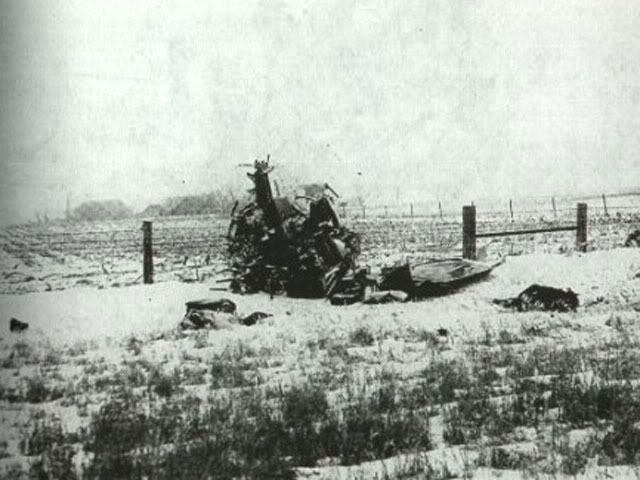
The plane would crash, and Holly, Richardson, Valens and Peterson would be dead, within five minutes of takeoff, as the direct result of pilot error.
On a cold winter's night a small private plane took off from Clear Lake, Iowa bound for Fargo, N.D. It never made its destination.
When that plane crashed, it claimed the lives of Buddy Holly, Ritchie Valens, J.P. "Big Bopper" Richardson and the pilot, Roger Peterson. Three of Rock and Roll's most promising performers were gone. As Don McLean wrote in his classic music parable, American Pie, (annotated) it was "the day the music died."
Performing in concert was very profitable, even more so than a cheap cash advance and Buddy Holly needed the money it provided. "The Winter Dance Party Tour" was planned to cover 24 cities in a short 3 week time frame (January 23 - February 15) and Holly would be the biggest headliner. Waylon Jennings, a friend from Lubbock, Texas and Tommy Allsup would go as backup musicians.
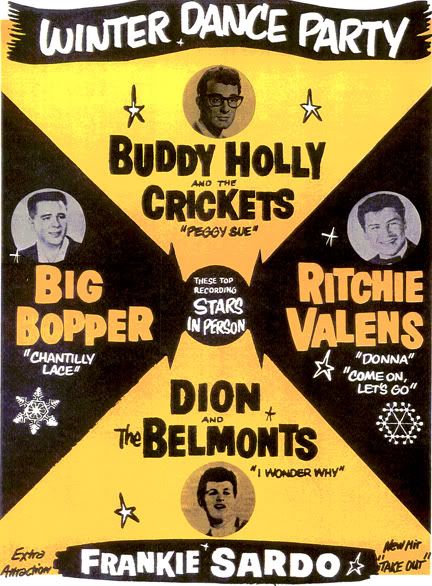
Ritchie Valens, probably the hottest of the artists at the time, The Big Bopper, and Dion and the Belmonts would round out the list of performers.
The tour bus developed heating problems. It was so cold onboard that reportedly one of the drummers developed frostbite riding in it. When they arrived at the Surf Ballroom in Clear Lake, Iowa, they were cold, tired and disgusted.
Buddy Holly had had enough of the unheated bus and decided to charter a plane for himself and his guys. At least he could get some laundry done before the next performance!
That night at the Surf Ballroom was magical as the fans went wild over the performers.
Jiles P. Richardson, known as The Big Bopper to his fans, was a Texas D.J. who found recording success and fame in 1958 with the song Chantilly Lace.
Richie Valenzuela was only 16 years old when Del-Fi record producer, Bob Keane, discovered the Pacoima, California singer. Keane rearranged his name to Ritchie Valens, and in 1958 they recorded Come On, Let's Go. Far more successful was the song Valens wrote for his girlfriend, Donna, and its flip side, La Bamba, a Rock and Roll version of an old Mexican standard. This earned the teenager an appearance on American Bandstand and the prospect of continued popularity.
Charles Hardin "Buddy" Holley (changed to Holly due to a misspelling on a contract) and his band, The Crickets, had a number one hit in 1957 with the tune That'll Be The Day. This success was follwed by Peggy Sue and an appearance on the Ed Sullivan Show. By 1959, Holly had decided to move in a new direction. He and the Crickets parted company. Holly married Maria Elena Santiago and moved to New York with the hope of concentrating on song writing and producing.
Dwyer Flying Service got the charter. $36 per person for a single engine Beechcraft Bonanza.
No, the plane wasn't named American Pie. It only had serial numbers, N3794N.
Waylon Jennings gave his seat up to Richardson, who was running a fever and had trouble fitting his stocky frame comfortably into the bus seats.
When Holly learned that Jennings wasn't going to fly, he said, "Well, I hope your old bus freezes up." Jennings responded, "Well, I hope your plane crashes." This friendly banter of friends would haunt Jennings for years.
Allsup told Valens, I'll flip you for the remaining seat. On the toss of a coin, Valens won the seat and Allsup the rest of his life.
The plane took off a little after 1 A.M. from Clear Lake and never got far from the airport before it crashed, killing all onboard.
A cold N.E wind immediately gave way to a snow which drastically reduced visibility. The ground was already blanketed in white. The pilot may have been inexperienced with the instrumentation.
One wing hit the ground and the small plane corkscrewed over and over. The three young stars were thrown clear of the plane, leaving only pilot Roger Peterson inside.
Over the years there has been much speculation as to whether a shot was fired inside the plane which disabled or killed the pilot. Logic suggests that encased in a sea of white snow, with only white below, Peterson just flew the plane into the ground.
Deciding that the show must go on at the next stop, Moorhead, MN, they looked for local talent to fill in. Just across the state line from Moorhead, in Fargo ND, they found a 15 year old talent named Bobby Vee.
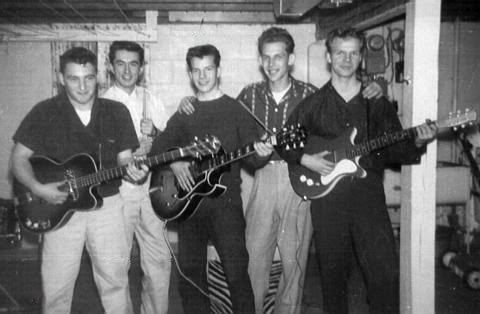
Bobby Vee (Vallein), middle guitar above, was a high school friend of mine when I attended Fargo Central High for a single year..1958-59… an 11th grader. We were in a car club together, called the Windjammers. I picked him up on the way to school every morning. He was already a local singing favorite and that fill-in destined him to his career.
I only knew him that one school year, Sept 1959 to May 1960. As his family life was not that great, he left school to start his singing career… and I went back to my hometown school to graduate with my boyhood friends.
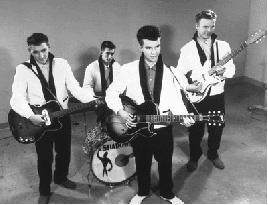
The crash that ended the lives of Holly, Valens and Richardson was the break that began the career of Bobby Vee.
I was at that Moorhead, Mn. concert with my date when Bobby's career was launched. (The Night Has A Thousand Eyes)
Bobby went to stardom...and...
(...of no historical importance at all, I got married to my concert date 10 years later.
 ...and now it's 43 years later and we're still very, very good friends.)
...and now it's 43 years later and we're still very, very good friends.)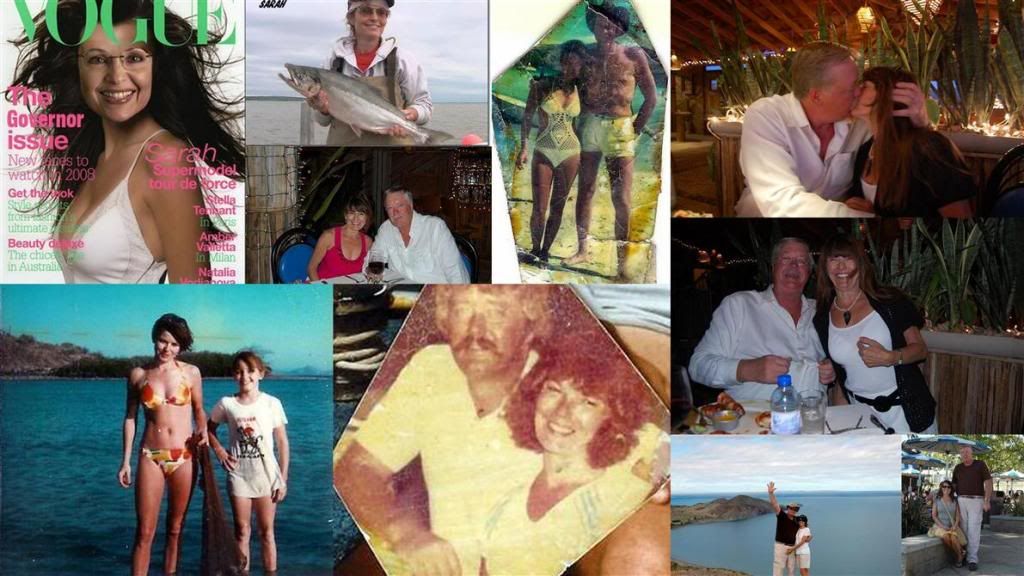
This photo was taken just 3 days before that fatal plane crash.
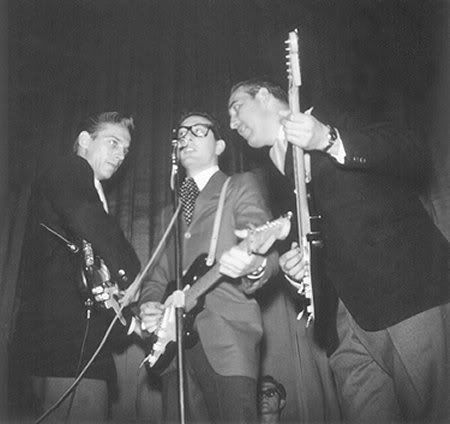
Tommy Allsup (far right) would one day open a club named "The Head's Up Saloon," a tribute to the coin toss that saved his life.
Buddy Holly - middle
Waylon Jennings (far left) would become a hugely popular Country singer.
Inscribed on Ritchie Valens' grave are the words, "Come On, Let's Go."
p.s. Now you know what the lyrics in ‘American Pie’ mean....the loss of rock 'n roll dance music ..on...'the day the music died'.








